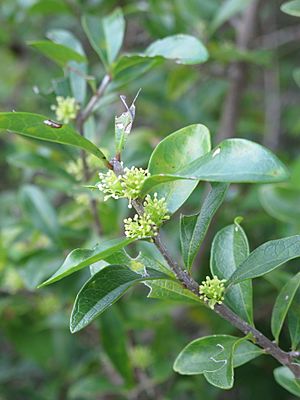Florida privet facts for kids
Quick facts for kids Florida privet |
|
|---|---|
 |
|
| Conservation status | |
| Scientific classification | |
| Genus: |
Forestiera
|
| Species: |
segregata
|
Forestiera segregata is a cool plant often called the Florida privet. It's part of the olive family, just like the olive trees that give us olives! You can find this plant growing naturally in places like the Bahamas, the Greater Antilles (which include Puerto Rico and the Cayman Islands), the Lesser Antilles (like Anguilla), and in the United States in Florida, Georgia, and South Carolina.
Contents
What Does the Florida Privet Look Like?
This plant can be a shrub (a bushy plant) or a small tree. It can grow quite tall, reaching about three to seven meters (10 to 23 feet) high. Its twigs are usually gray or brownish. They have tiny bumps called lenticels, which help the plant breathe.
Leaves, Flowers, and Fruit
The leaves of the Florida privet are shaped like a spear, oval, or like a spatula. They are narrow at the bottom and can be up to 5 to 7 centimeters (2 to 3 inches) long. This plant can be evergreen (keeping its leaves all year) or deciduous (losing its leaves in the fall).
The flowers are small and have a greenish-yellow color. Tiny insects help to pollinate them. After the flowers, the plant grows small fruits. These fruits are black or bluish and are called drupes. They are about a centimeter (less than half an inch) long. Be careful, though! These fruits can stain your clothes and skin. They also taste bad.
Different Kinds of Florida Privet
There are two main types, or varieties, of this plant. The most common one is called var. segregata. The other type is less common and is called var. pinetorum. You can find this rarer type in Florida, Georgia, and the Bahamas.
How People Use the Florida Privet
People sometimes plant the Florida privet in their gardens. It's often used to create a hedge. A hedge is like a living fence made of plants. The Florida privet is easy to trim and shape, making it a good choice for this purpose.


